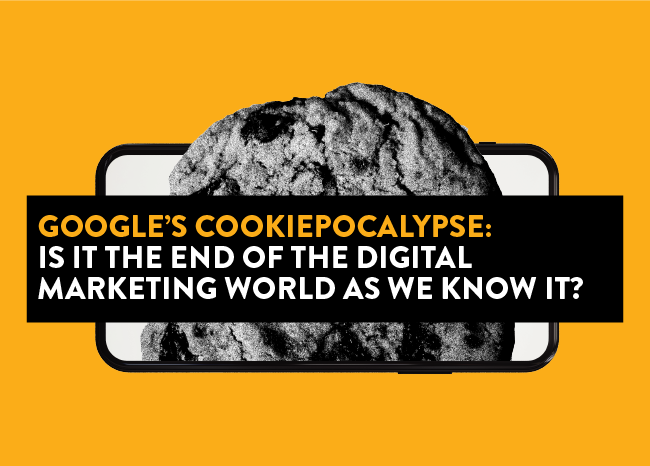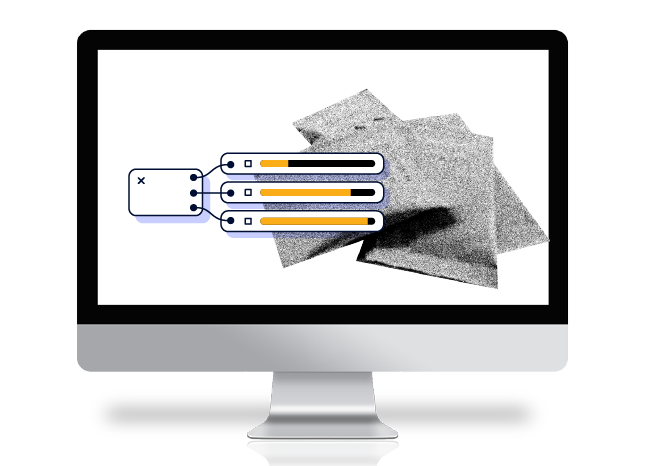 Google’s Cookiepocalypse: Is It the End of the Digital Marketing World as We Know It?
Google’s Cookiepocalypse: Is It the End of the Digital Marketing World as We Know It?
On January 14, 2020, Google announced that third-party cookies would be disappearing from Google Chrome. As Google has been the dominant force in online advertising for nearly a decade, this decision rocked the advertising world. So big, in fact, that it was quickly dubbed cookiepocalypse.
One motivation behind this major shift came from increasing concerns over user privacy violations, which is why Google is looking to discontinue and replace third-party cookies entirely. This is different from Mozilla’s and Apple’s strategies, which focused on blocking as opposed to elimination. In addition, as Chrome is the browser of choice for 65% of the world’s internet users, Google’s decision will have a significantly larger impact than its competitors’ cookie policies.
The major change falls under the scope of Google’s Privacy Sandbox project, and it has proven to be a major challenge; so large, in fact, that the actual date of cookiepocalypse has been pushed back multiple times.
As of August 2022, Google announced that it plans to launch the Privacy Sandbox APIs in Q3 of 2023 and that third-party cookies will be gone by the second half of 2024. While these dates may seem distant, it’s important for digital marketers and web designers to fully understand the importance of cookies, how their disappearance will end the marketing world as we know it, and how to prepare for cookiepocalypse.
What Is a Cookie and How Are They Used?
 Cookies are small packets of data that are created by a web server. When a user visits a website, the server generates the cookie and the web browser places the cookie on the user’s device. Cookies have been in use since the early stages of the internet — they were invented in 1994 to solve issues related to e-commerce — and utilizing cookie data is the most common method of identifying users online.
Cookies are small packets of data that are created by a web server. When a user visits a website, the server generates the cookie and the web browser places the cookie on the user’s device. Cookies have been in use since the early stages of the internet — they were invented in 1994 to solve issues related to e-commerce — and utilizing cookie data is the most common method of identifying users online.
First-party Cookies
Although they collect and utilize the same types of data, first-party and third-party cookies differ in the way that they are created and used. First-party cookies are created by the host domain, or the website that the user is currently visiting. First-party cookies store data on user preferences and make websites easier to use.
Websites commonly use first-party cookies to remember data such as a user’s login and password information, language preferences, and, in the case of e-commerce, what items a user has looked at and placed in their shopping carts.
First-party cookies also provide the data that is utilized by Google Analytics and Google Search Console. This type of cookie will be unaffected by cookiepocalypse. In addition, any marketing strategies that rely on organic searches or are content-based will likely remain unchanged.
Third-party Cookies
In contrast, third-party cookies come from domains that are not the ones that the user is currently visiting. They can be generated by pop-ups or ads and they “follow” users around the internet, tracking what sites they visit and utilize. Third-party cookies gather highly personalized data that is useful to digital marketers. Marketers can use cookie data to create detailed user personas that tell advertisers where to place their ads, which explains why ads seem to follow users around the internet. This follow-you-around-the-internet factor also explains why third-party cookies severely compromise user privacy on the web.
Third-party cookies will completely disappear once Google implements its changes; essentially, the tech giant will be eliminating a major cornerstone of many marketing strategies and campaigns. Over 80% of marketers are concerned about Google’s decision, and nearly 80% of marketers surveyed indicated that their digital marketing is “moderately reliant” or “very reliant” on third-party cookies.
The disappearance of third-party cookies will also have a major impact on digital advertising — not just for small businesses, but also for Google itself. Nearly 80% of Alphabet’s revenue in Q1 of 2022 came from ads, and third-party cookies are the driving force behind Google Ads. This is part of the reason why unveiling and testing the replacement for third-party cookies is so crucial.
What Will Replace Third-Party Cookies?
 In short, Google is looking to replace third-party cookies with a technology that is still useful for online advertising and marketing, but doesn’t compromise user privacy. This has proven to be more complicated than expected, and is part of the reason that the date for cookiepocalypse keeps shifting.
In short, Google is looking to replace third-party cookies with a technology that is still useful for online advertising and marketing, but doesn’t compromise user privacy. This has proven to be more complicated than expected, and is part of the reason that the date for cookiepocalypse keeps shifting.
Originally, Google proposed replacing third-party cookies with FLoC (Federated Learning of Cohorts). Essentially, this project would have allowed companies to track groups of users with common interests around the internet. However, many individuals in the tech world raised concerns that FLoCs would still greatly compromise user privacy. One key point in the opposition to FLoC was that individual users could be “fingerprinted” and identified within their cohorts. In addition, there were concerns that FLoC would violate anti-trust laws. Eventually, Google scrapped the project.
Google announced it was replacing FLoC with the Google Topics API in January 2022. This project aims to categorize the different websites that a user visits into topics, and then provide this data to advertisers. One benefit of Google Topics is that the data would only be kept for three weeks and then deleted. Google Topics is still in the testing stages, but companies should still start preparing now. This is because effective campaigns and strategy pivots take time to implement and longer to see results — for many, a change on the level of cookiepocalypse could take years to see through.
Why Good SEO Is Key for Surviving Cookiepocalypse
 Successfully shifting your brand from a marketing strategy reliant on third-party cookies will require some major pivots. Many businesses may need to overhaul how they gather data and shift from a third-party to a first-party approach. But it is clear that good SEO will be essential in a post-cookie world.
Successfully shifting your brand from a marketing strategy reliant on third-party cookies will require some major pivots. Many businesses may need to overhaul how they gather data and shift from a third-party to a first-party approach. But it is clear that good SEO will be essential in a post-cookie world.
The reason for this is that while paid advertising will be greatly affected by the disappearance of third-party cookies, search engine results pages (SERPs) and SEO will be impacted far less. This is because SEO does not rely on tracking users around the internet. Instead, it’s about getting users to see and interact with a website — and eventually purchase the goods or services that a company has to offer — organically. And because paid advertising and SEO should be used in tandem for best results, it’s very possible that when cookiepocalypse happens, SEO will probably be doing more of the legwork.
Steps Companies Can Take to Prepare for a Post-cookie World
 Now that you know what cookies are, how they work, and the implications of their disappearance, it’s time to analyze, and perhaps change, your marketing strategy. Here are some tips for maintaining and expanding your audience throughout the transition to a post-cookie web.
Now that you know what cookies are, how they work, and the implications of their disappearance, it’s time to analyze, and perhaps change, your marketing strategy. Here are some tips for maintaining and expanding your audience throughout the transition to a post-cookie web.
Optimize Your Website
Improving your website’s functionality is essential if you want your users to find and stay on your landing pages. If your website is currently experiencing a reduction in traffic or you aren’t seeing results from your current marketing campaigns, it’s safe to say that things won’t get better when cookiepocalypse happens. Conducting a full SEO audit of your site can allow you to identify problems that are resulting in poor ROIs.
Make Content Creation a Habit
If you can no longer follow users around the internet, you need to give them a reason to come to your website — and stay there. Creating high-quality content that users value is the main way to do this, but it’s also an ongoing process, not a one-and-done solution. Generating and posting new content to your website should be a process that you start right away, to reap the full results when third-party cookies disappear.
Build Relationships With Your Customers
Google has stated that “first-party relationships are vital” for brands to grow in a post-cookie world, so your content and your marketing strategy should shift towards personalization. Telling stories that resonate with your users is one way to do this.
Organically Grow Your Audience
Once your website is optimized and has plenty of high-quality content, you can start organically growing your audience through link building. Getting onto the first page of Google will have a major impact on who sees and connects with your company, and it is still possible to compete with larger companies on the SERPs, if you know what you are doing.
Follow Updates From Google
With such a large event on the digital marketing horizon, following updates from Google will be essential. This isn’t just because you need a firm date for when cookiepocalypse will happen, but also so that you are aware when Google Topics is in its testing stages. This information will be released well in advance, in part because of the scope of the project but also because Google tends to be transparent about its changes.
Cookiepocalypse Is a User-centered Approach the Internet Needs
 Finally, it’s important to recognize that Google is motivated to do the third-party cookie phase-out because it is interested in putting people first. Protecting user privacy on the web is not only essential to building and maintaining user trust, but it also ensures that the internet remains free and open. When done right, a post-cookie world will provide benefits to both users and marketers alike. So while cookiepocalypse might be the end of the world, it also points to a better and brighter future.
Finally, it’s important to recognize that Google is motivated to do the third-party cookie phase-out because it is interested in putting people first. Protecting user privacy on the web is not only essential to building and maintaining user trust, but it also ensures that the internet remains free and open. When done right, a post-cookie world will provide benefits to both users and marketers alike. So while cookiepocalypse might be the end of the world, it also points to a better and brighter future.

